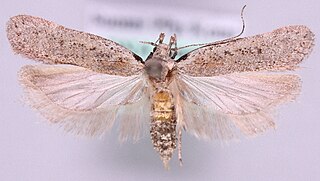Chlorolychnis is a genus of moths in the family Gelechiidae. It contains the species Chlorolychnis agnatella, which is found in Indonesia (Java) and Sri Lanka.

Gelechia is a genus of moths in the family Gelechiidae. The type species is Gelechia rhombella.

Izatha copiosella is a moth of the family Oecophoridae. It is endemic to New Zealand, where it is found on the south-eastern parts of the North Island and throughout the South Island except the West Coast. Larvae are found in dead wood and are likely to use kōwhai species as hosts. The adults are night fliers and are attracted to light. They are on the wing in January and February.

Heterocrossa adreptella is a moth of the Carposinidae family. This species was long considered the New Zealand raspberry budmoth however this was a taxonomic misinterpretation of the type material used to describe this species. This error was corrected in 1988 with the New Zealand raspberry budmoth giving its own species name Heterocrossa rubophaga. H. adreptella is endemic to New Zealand and has been collected in the Wellington Botanic Garden and been observed resting on mānuka branches.

Gelechia sabinellus, the juniper gelechiid moth, is a moth of the family Gelechiidae. It is known from most of Europe. It is an introduced species in Great Britain and North America through accidental introduction in garden junipers.
Paraplatyptilia modesta is a moth of the family Pterophoridae. It is found in North America.
Paraplatyptilia petrodactylus is a moth of the family Pterophoridae that is found in North America.

Oidaematophorus guttatus is a moth of the family Pterophoridae. It is found in the United States.
Gelechia flavipalpella is a moth of the family Gelechiidae. It is found in the Democratic Republic of Congo and South Africa.

Gelechia turpella, the grand groundling, is a moth of the family Gelechiidae. It is widely distributed in Europe. Outside of Europe, it is found from the Caucasus to Siberia and the Russian Far East. The habitat consists of woodlands and parks.
Gelechia abjunctella is a moth of the family Gelechiidae. It is found in South Africa.
Gelechia marmoratella is a moth of the family Gelechiidae. It is found in Australia, where it has been recorded from New South Wales.
Gelechia petraea is a moth of the family Gelechiidae. It is found in Guatemala.
Gelechia fecunda is a moth of the family Gelechiidae first described by Edward Meyrick in 1918. It is found in South Africa.
Gelechia mimella is a moth of the family Gelechiidae. It is found in North America, where it has been recorded from Pennsylvania.
Allotropha is a monotypic moth genus in the family Depressariidae described by Alexey Diakonoff in 1954. Its only species, Allotropha percussana, was described by Francis Walker in 1864. It is found in Australia, where it has been recorded from Tasmania.

Tingena collitella is a species of moth in the family Oecophoridae. It is endemic to New Zealand and has been observed in Auckland.

Tingena innotella is a species of moth in the family Oecophoridae. It is endemic to New Zealand and is found in both the North and South Islands. This species inhabits open native forest or scrubland and adults are on the wing from December to March. T. innotella appears to have an affinity for the silver tree fern.

Trachypepla conspicuella is a species of moth in the family Oecophoridae. It is endemic to New Zealand and is found in both the North and South Islands. It is similar in appearance to its close relative T. euryleucota but tends to be paler. Its colouration imitates bird droppings. Larvae feed on leaf litter. Adults of this species are on the wing from November to February and have been observed resting on fences and walls.

Trachypepla contritella, the Kiwi Enigma, is a species of moth in the family Oecophoridae. Originally endemic to New Zealand this species can be found throughout that country. However, from 2012 this species has been also been recorded in the United Kingdom. The preferred habitat of T. conritella is New Zealand native forest and larvae of this species are litter leaf feeders. Adults are on the wing from November to February in New Zealand and are attracted to light.









